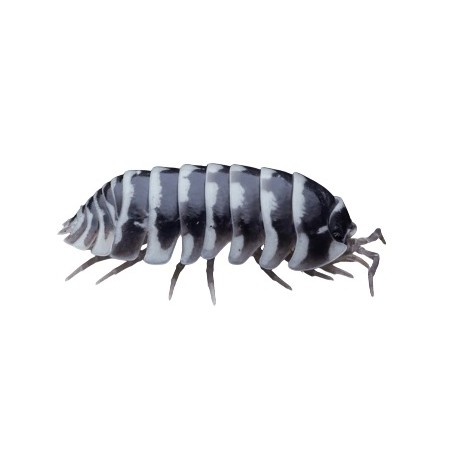- New

SPRING SALES are active on Herp Italia: every week new discounts on your favorite products.
DISCOVER THE OFFERS
Orders with insects or other arthropods are shipped to Italy only, on Monday, Tuesday and Wednesday. Any Zones with a minimum delivery time of 48 hours are generally managed on Mondays and Tuesdays. Please read theshipping and warranty terms carefully before placing your order.







Starter colony of 10 specimens of mixed sizes: Armadillidium vulgare maculatum - Zebra white? land isopods.
Zebra Armadillidium maculatum are one of the many varieties of the Armadillidium vulgare land crustacean species. This particular color variant is known as Zebra due to its black and white striped color. The specimens can grow up to 2 cm in a development period that varies between 9 and 10 months.
Along with other easy-to-manage species, zebras are among the most prolific and resistant!
• Customers are advised that the pieces purchased could be grouped in a package in order to optimize space. Orders with isopods are shipped ONLY on Monday, Tuesday and Wednesday.•
ATTENTION: upon receipt of shipments, place the packages containing isopods in a medium temperature environment for at least an hour (20/22°C) before opening them, so that they adapt to the climate difference. Below or above these temperatures the isopods will appear unresponsive, give them time to adjust before transferring them.
In nature they live on the ground of woods and forests, hiding among trunks and rocks during the day. In your bioactive terrariums you should try to recreate this habitat. The substrate should be created with a mixture of leaves, soil and rotten wood to provide basic food. A layer of moss and sphagnum, pieces of bark and other leaves should be placed on the substrate, so that on one side the animals can find shelter and on the other the substrate does not dry out too quickly.
Food: fruit, vegetables, flowers, mushrooms, molds, Collembolafix Springtail Feed, Various leaves;
Temperature: They are also active at temperatures of 18/20°C, a good management temperature is around 24°C;
Humidity: They like to have their habitat divided between a dry part and a humid environment on the other, the total humidity should be between 40 and 60%;
You can safely keep them together with snails and slugs, millipedes, phasmids, beetles, etc. If instead you decide to include them as detritivores for cleaning your terrarium with reptiles and amphibians you must take into account that they could become a succulent snack rich in calcium and chitin;
The isopods decompose the organic waste material of your animals inside the terrarium, keeping it always clean, also creating high-quality humus for your plants. Being detritivores they do NOT feed on live plants, so there is no problem that they can eat healthy plants in your habitat.
You might also like